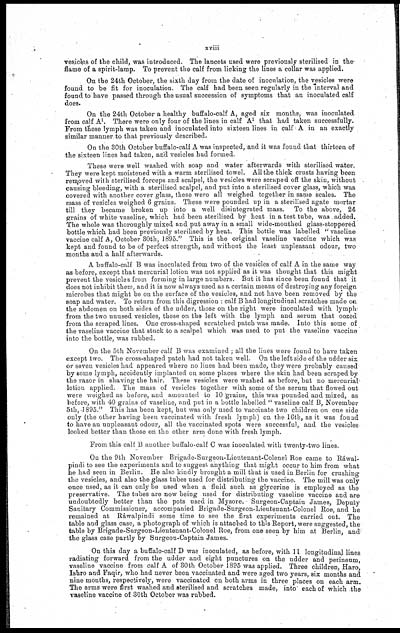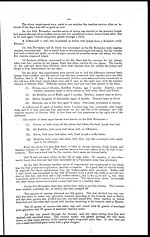Medicine - Vaccination > 1867-1929 - Report on vaccination in the Punjab > Vaccination in the Punjab 1883-1896 > 1895-1896 - Report on vaccination in the Punjab for the year 1895-96
(399) Page xviii
Download files
Individual page:
Thumbnail gallery: Grid view | List view

xviii
vesicles of the child, was introduced. The lancets used were previously sterilised in the-
flame of a spirit-lamp. To prevent the calf from licking the lines a collar was applied.
On the 24th October, the sixth day from the date of inoculation, the vesicles were
found to be fit for inoculation. The calf had been seen regularly in the interval and
found to have passed through the usual succession of symptoms that an inoculated calf
does.
On the 24th October a healthy buffalo-calf A, aged six months, was inoculated
from calf A1. There were only four of the lines in calf A1 that had taken successfully.
From these lymph was taken and inoculated into sixteen lines in calf A in an exactly
similar manner to that previously described.
On the 30th October buffalo-calf A was inspected, and it was found that thirteen of
the sixteen lines had taken, and vesicles had formed.
These were well washed with soap and water afterwards with sterilised water.
They were kept moistened with a warm sterilised towel. All the thick crusts having been
removed with sterilised forceps and scalpel, the vesicles were scraped off the skin, without
causing bleeding, with a sterilised scalpel, and put into a sterilised cover glass, which was
covered with another cover glass, these were all weighed together in same scales. The
mass of vesicles weighed 6 grains. These were pounded up in a sterilised agate mortar
till they became broken up into a well disintegrated mass. To the above, 24
grains of white vaseline, which had been sterilised by heat in a test tube, was added.
The whole was thoroughly mixed and put away in a small wide-mouthed glass-stoppered
bottle which had been previously sterilised by heat. This bottle was labelled "vaseline
vaccine calf A, October 30th, 1895." This is the original vaseline vaccine which was
kept and found to be of perfect strength, and without the least unpleasant odour, two
months and a half afterwards.
A buffalo-calf B was inoculated from two of the vesicles of calf A in the same way
as before, except that mercurial lotion was not applied as it was thought that this might
prevent the vesicles from forming in large numbers. But it has since been found that it
does not inhibit them, and it is now always used as a certain means of destroying any foreign
microbes that might be on the surface of the vesicles, and not have been removed by the
soap and water. To return from this digression : calf B had longitudinal scratches made on
the abdomen on both sides of the udder, those on the right were inoculated with lymph
from the two unused vesicles, those on the left with, the lymph and serum that oozed
from the scraped lines. One cross-shaped scratched patch was made. Into this some of
the vaseline vaccine that stuck to a scalpel which was used to put the vaseline vaccine
into the bottle, was rubbed.
On the 5th November calf B was examined ; all the lines were found to have taken
except two. The cross-shaped patch had not taken well. On the left side of the udder six
or seven vesicles had appeared where no lines had been made, they were probably caused
by some lymph, accidently implanted on some places where the skin had been scraped by
the razor in shaving the hair. These vesicles were washed as before, but no mercurial
lotion applied. The mass of vesicles together with some of the serum that flowed out
were weighed as before, and amounted to 10 grains, this was pounded and mixed, as
before, with 40 grains of vaseline, and put in a bottle labelled " vaseline calf B, November
5th,1895." This has been kept, but was only used to vaccinate two children on one side
only (the other having been vaccinated with fresh lymph) on the l6th, as it was found
to have an unpleasant odour, all the vaccinated spots were successful, and the vesicles
looked better than those on the other arm done with fresh lymph.
From this calf B another buffalo-calf C was inoculated with twenty-two lines.
On the 9th November Brigade-Surgeon-Lieutenant-Colenel Roe came to Ráwal-
pindi to see the experiments and to suggest anything that might occur to him from what
he had seen in Berlin. He also kindly brought a mill that is used in Berlin for crushing
the vesicles, and also the glass tubes used for distributing the vaccine. The mill was only
once used, as it can only be used when a fluid such as glycerine is employed as the
preservative. The tubes are now being used for distributing vaseline vaccine and are
undoubtedly better than the pots used in Mysore. Surgeon-Captain James, Deputy
Sanitary Commissioner, accompanied Brigade-Surgeon-Lieutenant-Colonel Roe, and he
remained at Ráwalpindi some time to see the first experiments carried out. The
table and glass case, a photograph of which is attached to this Report, were suggested, the
table by Brigade-Surgeon-Lieutenant-Colonel Roe, from one seen by him at Berlin, and
the glass case partly by Surgeon-Captain James.
On this day a buffalo-calf D was inoculated, as before, with 11 longitudinal lines
radiating forward from the udder and eight punctures on the udder and perineum,
vaseline vaccine from calf A of 30th October 1895 was applied. Three children Haro,
Ishro and Faqir, who had never been vaccinated and were aged two years, six: months and
nine months, respectively, were vaccinated on both arms in three places on each arm.
The arms were first washed and sterilised and scratches made, into each of which the
vaseline vaccine of 30th October was rubbed.
Set display mode to: Large image | Zoom image | Transcription
Images and transcriptions on this page, including medium image downloads, may be used under the Creative Commons Attribution 4.0 International Licence unless otherwise stated. ![]()
| India Papers > Medicine - Vaccination > Report on vaccination in the Punjab > Vaccination in the Punjab 1883-1896 > Report on vaccination in the Punjab for the year 1895-96 > (399) Page xviii |
|---|
| Permanent URL | https://digital.nls.uk/87217364 |
|---|
| Attribution and copyright: |
|
|---|



![[Page xvii]](https://deriv.nls.uk/dcn4/8721/87217363.4.jpg)
